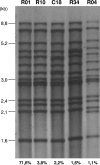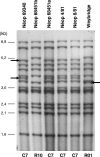New variable-number tandem-repeat markers for typing Mycobacterium avium subsp. paratuberculosis and M. avium strains: comparison with IS900 and IS1245 restriction fragment length polymorphism typing
- PMID: 17537942
- PMCID: PMC1951273
- DOI: 10.1128/JCM.00476-07
New variable-number tandem-repeat markers for typing Mycobacterium avium subsp. paratuberculosis and M. avium strains: comparison with IS900 and IS1245 restriction fragment length polymorphism typing
Abstract
Mycobacterium avium subsp. paratuberculosis, the etiological agent of paratuberculosis, affects a wide range of domestic ruminants and has been suggested to be involved in Crohn's disease in humans. Most available methods for identifying and differentiating strains of this difficult species are technically demanding and have limited discriminatory power. Here, we report the identification of novel PCR-based typing markers consisting of variable-number tandem repeats (VNTRs) of genetic elements called mycobacterial interspersed repetitive units (MIRUs). Eight markers were applied to 183 M. avium subsp. paratuberculosis isolates from bovine, caprine, ovine, cervine, leporine, and human origins from 10 different countries and to 82 human isolates of the closely related species M. avium from France. Among the M. avium subsp. paratuberculosis isolates, 21 patterns were found by MIRU-VNTR typing, with a discriminatory index of 0.751. The predominant R01 IS900 restriction fragment length polymorphism type, comprising 131 isolates, was divided into 15 MIRU-VNTR types. Among the 82 M. avium isolates, the eight MIRU-VNTR loci distinguished 30 types, none of which was shared by M. avium subsp. paratuberculosis isolates, resulting in a discriminatory index of 0.889. Our results suggest that MIRU-VNTR typing is a fast typing method that, in combination with other methods, might prove to be optimal for PCR-based molecular epidemiological studies of M. avium/M. avium subsp. paratuberculosis pathogens. In addition, presumably identical M. avium subsp. paratuberculosis 316F vaccine strains originating from the Weybridge laboratory and from different commercial batches from Mérial actually differed by one or both typing methods. These results indicate a substantial degree of genetic drift among different vaccine preparations, which has important implications for prophylactic approaches.
Figures



References
-
- Bull, T. J., K. Sidi-Boumedine, E. J. McMinn, K. Stevenson, R. Pickup, and J. Hermon-Taylor. 2003. Mycobacterial interspersed repetitive units (MIRU) differentiate Mycobacterium avium subspecies paratuberculosis from other species of the Mycobacterium avium complex. Mol. Cell. Probes 17:157-164. - PubMed
-
- Collins, D. M., S. Cavaignac, and G. W. de Lisle. 1997. Use of four DNA insertion sequences to characterize strains of the Mycobacterium avium complex isolated from animals. Mol. Cell. Probes 11:373-380. - PubMed
Publication types
MeSH terms
Substances
LinkOut - more resources
Full Text Sources
Other Literature Sources
Molecular Biology Databases

